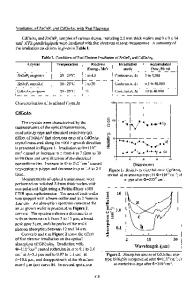Effect of Surface Modification on the Electrical Properties of TiO 2 and SnO 2 Nanopowders
- PDF / 471,097 Bytes
- 6 Pages / 414.72 x 648 pts Page_size
- 34 Downloads / 415 Views
"Contactauthor :[email protected] 89 Mat. Res. Soc. Symp. Proc. Vol. 501 © 1998 Materials Research Society
The activation removes all physisorbed and weakly chemisorbed species from the surface. In order to limit the reducing effect of the activation, n-SnO2 was activated at lower temperature (200-C). HMDS and HMDSO (from FLUKA, 99% pure), gaseous CO (from Air Products, less than 20 ppm H20) were used as received. Water was bidistilled and deionised. SURFACE MODIFICATION OF TITANIUM DIOXIDE The chemical species constituting the first atomic layer of TiO 2 nanoparticles are mostly OH hydroxyl groups. These OH groups create hydrogen bonds with atmospheric water molecules when the n-TiO2 powder is kept under ambient conditions. The v(OH) stretching vibrations of the perturbed OH groups appear as a broad band centered around 3500 cm-', in the IR spectrum. During the activation treatment, the hydrogen-bonded water is eliminated. In the 4000-3000 cm-' region, the spectrum (Fig. la) exhibits at least six bands at 3725, 3716, 3674, 3665, 3639 and 3478 cm1. They are assigned to the v(OH) stretching vibrations of surface hydroxyl groups in different configurations or crystalline structures [5,6]. According to several authors, both bands at
3716 and 3665 cm1 are due to hydroxyls bonded to Ti atoms in the anatase structure whereas the bands at 3674, 3639 and 3478 correspond to OH groups of the rutile structure [7]. The shoulder at 3725 cm1, more or less detectable depending on the samples, is attributed to hydroxyls bonded to silicon impurities present in the powder (
Data Loading...











